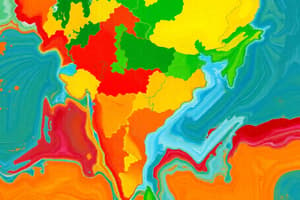Podcast
Questions and Answers
Which state in India is the most populous?
Which state in India is the most populous?
- Kerala
- Maharashtra
- Tamil Nadu
- Uttar Pradesh (correct)
How does the landmass of India compare to the United States?
How does the landmass of India compare to the United States?
- India has a smaller landmass than the United States (correct)
- The comparison of landmass is not mentioned in the text
- India has a larger landmass than the United States
- India and the United States have similar landmasses
Which of the following is NOT a Union Territory of India?
Which of the following is NOT a Union Territory of India?
- Chandigarh
- Delhi
- Goa (correct)
- Puducherry
What unique characteristic does India's location offer due to its position?
What unique characteristic does India's location offer due to its position?
Which of the following countries does NOT share a land border with India?
Which of the following countries does NOT share a land border with India?
What feature distinguishes Union Territories from states in India?
What feature distinguishes Union Territories from states in India?
Which topographical feature forms a natural barrier along India's northern frontier with China and Afghanistan?
Which topographical feature forms a natural barrier along India's northern frontier with China and Afghanistan?
Which river basin covers approximately three thousand kilometers through northern India?
Which river basin covers approximately three thousand kilometers through northern India?
In which latitude range mostly lies India geographically?
In which latitude range mostly lies India geographically?
Which region experiences harsh winters near the foothills of the Himalayas?
Which region experiences harsh winters near the foothills of the Himalayas?
How many states and union territories does India consist of?
How many states and union territories does India consist of?
Approximately how many square kilometers is India's total area?
Approximately how many square kilometers is India's total area?
Flashcards are hidden until you start studying
Study Notes
Physical Features of India
With its diverse landscape shaped by geological history, India is home to a variety of topographical features. The Deccan Plateau stretches across central and southern regions, while the Himalayas form a natural barrier along India's northern frontier with China and Afghanistan. These lofty mountains play crucial roles in shaping India's climate, precipitation patterns, and local ecosystems.
The Ganges River basin covers approximately three thousand kilometers through northern India, flowing from west to east into Bangladesh before emptying into the Bay of Bengal. India also contains several peninsulas like the Kaveri Delta in the south and numerous islands including Lakshadweep off its western coast, Andaman & Nicobar Islands further southeast, and various small territories scattered throughout the Indian Ocean.
Latitude and Longitude of India
Geographically speaking, India lies mostly between latitudes 8°N and 37°N and longitudes 68°E and 97°E. This substantial area encompasses vastly different climates and terrains. For example, Jammu and Kashmir situated near the foothills of the Himalayas experience harsh winters, while Kerala in Southwest India enjoys monsoon seasons alternating with dry spells.
States and Union Territories of India
India consists of 28 states and nine union territories. At almost 3 million square kilometers, it's one of the largest countries globally. Some notable states include Uttar Pradesh—the most populous state—in north-central India, Maharashtra in western India, and Tamil Nadu in Southern India; each contributes significantly to both population density and economic productivity.
Union territories differ from states because they do not have their own constitutions. They are administered directly by the Central Government of India. Examples of Union Territories include Delhi, Chandigarh, Dadra and Nagar Haveli, Daman and Diu, Lakshadweep, Puducherry, etc. Each has unique characteristics derived from factors such as heritage, culture, and demographic makeup.
Size of India
As mentioned earlier, India occupies nearly 3 million square kilometers, making it the seventh largest country worldwide after Russia, Canada, Brazil, Australia, China, and the United States. Despite this expanse, India has a relatively low landmass compared to nations like the United States, which consists of over 9 million square kilometers. Even so, India boasts a tremendous diversity of landscapes, cultures, languages, and traditions—all within these borders.
Location of India
Strategically located at the intersection of Eurasian and African plate tectonic boundaries, India shares land borders with seven neighboring sovereign states: Pakistan, China, Nepal, Bhutan, Myanmar, Bangladesh, and Sri Lanka. Additionally, India faces significant maritime neighbors like Indonesia, Malaysia, Singapore, Thailand, Maldives, Mauritius, Seychelles, Comoros, Madagascar, Reunion Island, and Mauritania. Its unique position allows India to interact with countries positioned in all four cardinal directions. Moreover, being a peninsula enhances the significance of sea trade routes.
Studying That Suits You
Use AI to generate personalized quizzes and flashcards to suit your learning preferences.




